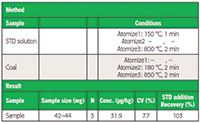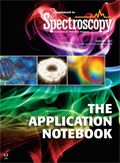Total Mercury in Coal Using Direct Mercury Analysis
Application Notebook
This application note demonstrates the ability of the NIC MA-3000 direct mercury analyzer to analyze coal samples with accuracy and precision, in compliance with ASTM D-6722-01 (Standard Test Method for Total Mercury in Coal and Coal Combustion Residues by Direct Combustion Analysis).
Since mercury occurs naturally in coal and other fossil fuels, when these fuels are burned for energy, the mercury becomes volatilized and airborne into the atmosphere. In the United States, power plants that burn coal to create electricity account for about half of all man-made mercury emissions. In nature, elemental mercury can go through a series of chemical transformations that convert it to highly toxic forms that are concentrated in fish and birds.
The most toxic form of mercury is methylmercury, an organic form created by a complex bacterial conversion of inorganic mercury. Mercury from the food chain is known to bioaccumulate in humans, as bioaccumulation in fish and birds carries over into human populations, where it can result in mercury poisoning. Mercury is dangerous to both natural ecosystems and humans because it is highly toxic, especially because of its ability to damage the central nervous system. Mercury poses a particular threat to human development in utero and in early childhood. Thus, to prevent mercury poisoning, it is necessary to accurately quantify total mercury in coal so that mercury emissions into the atmosphere may be carefully controlled.

Experimental Conditions
Coal samples are ground with a mortar to avoid segregation effect.
Calibration is done using certified aqueous ionic-mercury standard solution diluted to the required concentration. The least-squares regression method is used to create and complete the calibration curve.
Analysis was performed using the NIC MA-3000 dedicated direct mercury analyzer that selectively measures total mercury by thermal decomposition, gold amalgamation, and cold vapor atomic absorption spectroscopy. The MA-3000 analyzer measures mercury in virtually any sample matrix-solid, liquid, and gas-and offers quick results without time-consuming or elaborate sample preparation processes.
Results

Conclusion
This report demonstrates that NIC MA-3000 is able to reproduce good STD addition recovery of coal. NIC MA-3000 analyzes coal samples with accuracy and precision. It is a perfect solution to today's increasing laboratory demand for easy, fast, and accurate mercury measurements.
References
(1) WHO HP: http://www.who.int/ipcs/assessment/public_health/mercury/en/.
(2) US EPA: https://www.epa.gov/air-emissions-inventories/2011-national-emissions-inventory-nei-technical-support-document.
(3) USGS: https://pubs.usgs.gov/fs/fs095-01/fs095-01.html.

Nippon Instruments Corporation
14-8, Akaoji-cho, Takatsuki-shi, Osaka. 569-1149
tel. 72-694-5195, fax 81-72-694-0063
Website: www.hg-nic.com
